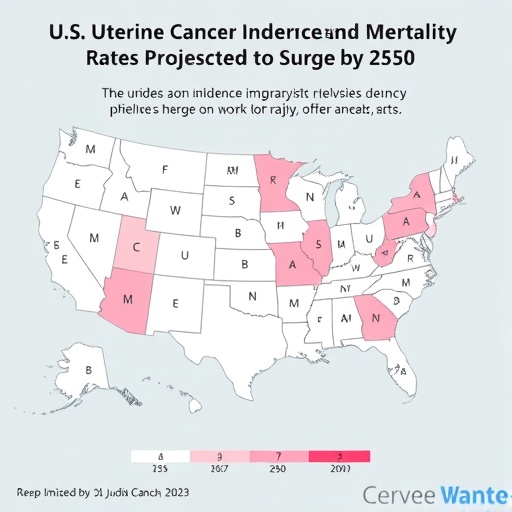Uterine cancer, a malignancy traditionally regarded as less common than other gynecologic cancers, is poised to become a major public health concern in the United States over the coming decades. Recent projections reveal a troubling increase in both the incidence and mortality rates associated with this disease, with a particularly disproportionate impact on Black women. A groundbreaking study led by Dr. Jason D. Wright, chief of the Division of Gynecologic Oncology at Columbia University, underscores these alarming trends and sheds light on the underlying dynamics that may fuel this disparity.
Historically, many cancer types in the United States have shown declining incidence and mortality rates, a testament to advancements in early detection, prevention, and treatment. However, uterine cancer appears to defy this trend. According to data from the National Cancer Institute’s Surveillance, Epidemiology, and End Results (SEER) Program, uterine cancer cases rose by an average of 0.7% per year from 2013 to 2022, while age-adjusted mortality escalated by 1.6% annually between 2014 and 2023. More concerningly, Black women suffer nearly double the death rates compared to their white counterparts, emphasizing a stark racial disparity that demands urgent attention.
To tackle these troubling statistics, Dr. Wright and his colleagues developed a sophisticated natural history model known as the Columbia University Uterine Cancer Model (UTMO). This model employs a robust simulation framework that incorporates numerous variables such as age, race, birth cohorts, cancer stage, and histologic subtype to forecast future trends through 2050. By taking into account distinctions between endometrioid and non-endometrioid uterine cancers, the model offers insights into how different tumor types contribute to overall disease burden across racial groups.
.adsslot_gODchZ34Nx{ width:728px !important; height:90px !important; }
@media (max-width:1199px) { .adsslot_gODchZ34Nx{ width:468px !important; height:60px !important; } }
@media (max-width:767px) { .adsslot_gODchZ34Nx{ width:320px !important; height:50px !important; } }
ADVERTISEMENT
Validation of the UTMO against real-world data from 2018 granted confidence in its predictive power. The model accurately estimated median age at diagnosis, survival rates, and stage distribution of uterine cancers, aligning closely with SEER data for that year. Leveraging these validated projections, the study examined how incidence and mortality rates might evolve under current epidemiologic and clinical conditions, as well as under hypothetical interventions.
Projections paint a grim picture for the decades ahead. Between 2018 and 2050, incidence rates are expected to rise from 57.7 to 74.2 cases per 100,000 white women and from 56.8 to 86.9 cases per 100,000 Black women. More strikingly, the mortality rate, tied directly to outcomes after diagnosis, is expected to nearly double for white women (from 6.1 to 11.2 per 100,000) and more than double for Black women, surging from 14.1 to 27.9 per 100,000. This dramatic divergence suggests that racial disparities in uterine cancer will not only persist but potentially worsen without effective interventions.
Diving deeper into tumor subtypes reveals additional complexity. Endometrioid tumors, generally associated with better prognosis, are projected to increase substantially among both Black and white women. However, the incidence of non-endometrioid tumors, which typically have a worse clinical outlook, is expected to rise more sharply in Black women, climbing from 22.5 to 36.3 cases per 100,000 compared to a subtler increase in white women from 8.5 to 10.8. This asymmetry likely contributes significantly to the observed mortality disparities and points towards biologic and systemic factors influencing disease aggressiveness and outcomes.
Notably, the model accounts for trends in two modifiable risk factors: hysterectomy rates and obesity. Historically, hysterectomy has served as a preventive measure against uterine cancer by removing the uterus entirely. Yet, anticipated declines in hysterectomy procedures — projected to fall by 25.7% from 2020 to 2035 due to emerging nonsurgical alternatives for gynecologic conditions — may inadvertently elevate cancer risk across populations. In parallel, rising obesity rates, a well-established risk factor linked to hormonally driven carcinogenesis in the endometrium, threaten to exacerbate this trend unless countered by effective interventions.
While new obesity treatments such as GLP-1 receptor agonists offer promise for reversing some of these risks, the model refrains from assuming their widespread adoption, reflecting uncertainty surrounding long-term public health impacts. The interplay of these factors exemplifies the multifaceted challenges confronting uterine cancer prevention and underscores the need for comprehensive strategies addressing behavioral, clinical, and social determinants of health.
Importantly, racial disparities in uterine cancer extend beyond incidence and subtype variations. Dr. Wright emphasizes that Black women often experience delayed diagnoses, leading to later-stage disease, as well as barriers to timely and effective treatment. These systemic obstacles compound the intrinsic aggressiveness of certain tumor types more prevalent within this population, collectively driving poorer outcomes. Addressing these inequities will require concerted efforts spanning healthcare access, patient education, and provider awareness.
In an exploratory “stress test” of the UTMO, researchers simulated the introduction of hypothetical screening and early intervention methods capable of detecting uterine cancer or precancerous changes prior to clinical diagnosis. When applied beginning at age 55, such screening initiatives reduced incidence rates for up to 15 years in white women and 16 years in Black women, illustrating the transformative potential of early detection. Although no standard screening protocol currently exists for uterine cancer, these findings provide a compelling rationale for developing and integrating effective detection tools into clinical practice.
The study does acknowledge certain limitations inherent to its modeling approach. UTMO relies on population-level data that may not fully capture individual variation or emerging risk factors yet to be quantified. Specific subtypes such as uterine sarcomas remain understudied, and the focus strictly on Black and white women precludes insights into trends among other racial and ethnic groups. Furthermore, the model assumes static survival estimates based on current treatments, without accounting for future therapeutic advances that could alter mortality trajectories.
Despite these constraints, this research constitutes a pivotal contribution to understanding the evolving epidemiology of uterine cancer in the U.S. By quantifying expected rising incidence and mortality, unpacking racial disparities, and highlighting modifiable contributors such as obesity and hysterectomy trends, it lays the groundwork for targeted public health interventions. Dr. Wright and his team emphasize that combating the projected burden will necessitate innovations in screening, improved access to timely diagnosis and treatment, and strategies tailored to mitigate inequities that disproportionately affect Black women.
The implications of these findings extend beyond uterine cancer alone, spotlighting the critical intersection of cancer biology, health disparities, and population health dynamics. As America’s demographic and behavioral landscape continues to shift, models like UTMO offer invaluable foresight to guide policymakers, researchers, and clinicians. In the absence of proactive measures, the growing toll of uterine cancer threatens to undermine decades of progress in cancer control, making this an urgent public health priority.
In conclusion, the predicted surge in uterine cancer incidence and mortality calls for immediate action to develop effective screening strategies, expand access to evidence-based care, and address social determinants that fuel disparities. While challenges remain, this study highlights a rare opportunity to intervene before the burden escalates further, potentially altering the future trajectory of this deadly disease.
Subject of Research: Projected trends in uterine cancer incidence and mortality with a focus on racial disparities in the United States
Article Title: Projected Trends in the Incidence and Mortality of Uterine Cancer in the United States
News Publication Date: 1-Jul-2025
Web References: DOI: 10.1158/1055-9965.EPI-24-1422
Keywords: Uterine cancer, mortality rates, racial disparities, cancer incidence, gynecologic oncology, endometrioid tumors, non-endometrioid tumors, obesity, hysterectomy, cancer screening, epidemiologic modeling
Tags: Black women and uterine cancercancer treatment disparitiesColumbia University cancer researchearly detection of uterine cancerfuture of uterine cancer in AmericaGynecologic oncology advancementsNational Cancer Institute datapublic health concerns uterine cancerracial disparities in cancer outcomestrends in cancer mortalityU.S. uterine cancer mortality ratesUterine cancer incidence projections





